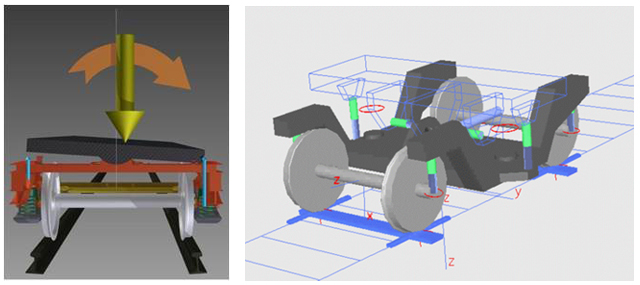Vehicle dynamics modelisation

Study of the dynamics of rail vehicles and their components, using numerical models and simulation programmes. This involves the commercial tool SIMPACK and an in-house simulation software package known as DINATREN. These tools can perform an analysis of the vehicle on straight and curved track, work with elastic multi-point wheel-rail contact models, and obtain major ride parameters to demonstrate whether the design is suitable.
Some of the results that may be obtained from the dynamic models are as follows:
-
Critical speed of the vehicle, beyond which movement over straight sections of track is rendered unstable. This is a crucial parameter for increasing operating speed without compromising ride safety and comfort.
-
Risk of derailment. Several estimators can ascertain, at any given time during the ride, the possibility of derailment when the flange climbs up the rail.
-
Confort. A train is possibly the most comfortable mode of passenger transport there is. By way of a contrast to the obvious discomforts of air travel (cramped seating, turbulence, noise, the need for auxiliary transit between the airport and the city of destination etc.), and the weariness induced by a long journey by road, the train option provides passengers with a relaxing, efficient means of transport. This means it is necessary to reduce ride noise levels, vibration and acceleration in passenger cars. All this can be calculated during the phase of dynamic simulation of the vehicle.

-
Steering efforts on curves. When a train negotiates a curve, the forces transmitted by the rails to the vehicle through its wheels affect steering and compensation for centrifugal forces. Depending on the characteristics of the vehicle and the curve, these forces can occasionally be very large indeed, with an adverse effect on a number of factors: wheel and rail wear, ride safety, track shifting etc. One of the essential purposes of dynamic simulations is to help railway vehicles to negotiate curves properly.
-
Wear. A major portion of a railway line’s maintenance outlay is accounted for by wear on wheels and rails during train rides, and this can be a large percentage of the total operating costs. Any factors that reduce wear as the vehicle moves over the track will be essential and enormously important in terms of savings on line operating costs. A proper dynamic simulation estimates and forecasts future wear under certain ride conditions, and will enable the vehicle parameters to be optimised in order to reduce wear to the bare minimum.

